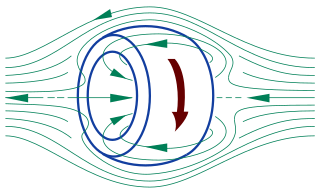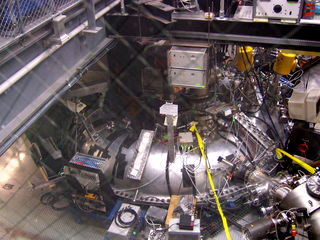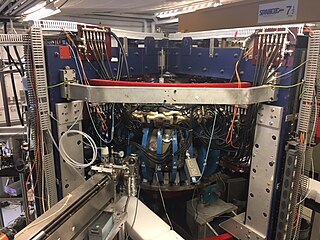
Fusion power is a proposed form of power generation that would generate electricity by using heat from nuclear fusion reactions. In a fusion process, two lighter atomic nuclei combine to form a heavier nucleus, while releasing energy. Devices designed to harness this energy are known as fusion reactors. Research into fusion reactors began in the 1940s, but as of 2023, no device has reached net power.

A reversed-field pinch (RFP) is a device used to produce and contain near-thermonuclear plasmas. It is a toroidal pinch which uses a unique magnetic field configuration as a scheme to magnetically confine a plasma, primarily to study magnetic confinement fusion. Its magnetic geometry is somewhat different from that of the more common tokamak. As one moves out radially, the portion of the magnetic field pointing toroidally reverses its direction, giving rise to the term reversed field. This configuration can be sustained with comparatively lower fields than that of a tokamak of similar power density. One of the disadvantages of this configuration is that it tends to be more susceptible to non-linear effects and turbulence. This makes it a useful system for studying non-ideal (resistive) magnetohydrodynamics. RFPs are also used in studying astrophysical plasmas, which share many common features.

Inertial electrostatic confinement, or IEC, is a class of fusion power devices that use electric fields to confine the plasma rather than the more common approach using magnetic fields found in magnetic confinement fusion (MCF) designs. Most IEC devices directly accelerate their fuel to fusion conditions, thereby avoiding energy losses seen during the longer heating stages of MCF devices. In theory, this makes them more suitable for using alternative aneutronic fusion fuels, which offer a number of major practical benefits and makes IEC devices one of the more widely studied approaches to fusion.

The Large Helical Device (LHD) is a fusion research device located in Toki, Gifu, Japan. It is operated by the National Institute for Fusion Science, and is the world's second-largest superconducting stellarator, after Wendelstein 7-X. The LHD employs a heliotron magnetic field originally developed in Japan.

The Levitated Dipole Experiment (LDX) was an experiment investigating the generation of fusion power using the concept of a levitated dipole. The device was the first of its kind to test the levitated dipole concept and was funded by the US Department of Energy. The machine was also part of a collaboration between the MIT Plasma Science and Fusion Center and Columbia University, where another (non-levitated) dipole experiment, the Collisionless Terrella Experiment (CTX), was located.

Magnetic confinement fusion (MCF) is an approach to generate thermonuclear fusion power that uses magnetic fields to confine fusion fuel in the form of a plasma. Magnetic confinement is one of two major branches of controlled fusion research, along with inertial confinement fusion.

A field-reversed configuration (FRC) is a type of plasma device studied as a means of producing nuclear fusion. It confines a plasma on closed magnetic field lines without a central penetration. In an FRC, the plasma has the form of a self-stable torus, similar to a smoke ring.

The Madison Symmetric Torus (MST) is a reversed field pinch (RFP) physics experiment with applications to both fusion energy research and astrophysical plasmas.

The Wendelstein 7-X reactor is an experimental stellarator built in Greifswald, Germany, by the Max Planck Institute for Plasma Physics (IPP), and completed in October 2015. Its purpose is to advance stellarator technology: though this experimental reactor will not produce electricity, it is used to evaluate the main components of a future fusion power plant; it was developed based on the predecessor Wendelstein 7-AS experimental reactor.
The polywell is a design for a fusion reactor based on two ideas: heating ions by concentrating (-) charge to accelerate the ions and trapping a diamagnetic plasma inside a cusp field.

The Helically Symmetric Experiment, is an experimental plasma confinement device at the University of Wisconsin–Madison, with design principles that are intended to be incorporated into a fusion reactor. The HSX is a modular coil stellarator which is a toroid-shaped pressure vessel with external electromagnets which generate a magnetic field for the purpose of containing a plasma. It began operation in 1999.
TAE Technologies, formerly Tri Alpha Energy, is an American company based in Foothill Ranch, California developing aneutronic fusion power. The company's design relies on an advanced beam-driven field-reversed configuration (FRC), which combines features from accelerator physics and other fusion concepts in a unique fashion, and is optimized for hydrogen-boron fuel, also known as proton-boron and p-B11. It regularly publishes theoretical and experimental results in academic journals with hundreds of publications and posters at scientific conferences and in a research library hosting these articles on its website. TAE has developed five generations of original fusion platforms with a sixth currently in development. It aims to manufacture a prototype commercial fusion reactor by 2030.

The Hybrid Illinois Device for Research and Applications (HIDRA) is a medium-sized toroidal magnetic fusion device housed in the Nuclear Radiation Laboratory and operated by the Center for Plasma-Material Interactions (CPMI) within the Department of Nuclear, Plasma and Radiological Engineering at the University of Illinois at Urbana–Champaign, United States. HIDRA had its first plasma at the end of April 2016 and started experimental campaigns by December of that year. HIDRA is the former WEGA classical stellarator that was operated at the Max Planck Institute for Plasma Physics in Greifswald Germany from 2001 to 2013.

The Princeton field-reversed configuration (PFRC) is a series of experiments in plasma physics, an experimental program to evaluate a configuration for a fusion power reactor, at the Princeton Plasma Physics Laboratory (PPPL). The experiment probes the dynamics of long-pulse, collisionless, low s-parameter field-reversed configurations (FRCs) formed with odd-parity rotating magnetic fields. FRCs are the evolution of the Greek engineer's Nicholas C. Christofilos original idea of E-layers which he developed for the Astron fusion reactor. The PFRC program aims to experimentally verify the physics predictions that such configurations are globally stable and have transport levels comparable with classical magnetic diffusion. It also aims to apply this technology to the Direct Fusion Drive concept for spacecraft propulsion.

The ITER Neutral Beam Test Facility is a part of the International Thermonuclear Experimental Reactor (ITER) in Padova, Veneto, Italy. The facility will host the full-scale prototype of the reactor's neutral beam injector, MITICA, and a smaller prototype of its ion source, SPIDER. SPIDER started its operation in June 2018. SPIDER will be used to optimize the ion beam source, to optimize the use of cesium vapor, and to verify the uniformity of the extracted ion beam also during long pulses.

The Compact Toroidal Hybrid (CTH) is an experimental device at Auburn University that uses magnetic fields to confine high-temperature plasmas. CTH is a torsatron type of stellarator with an external, continuously wound helical coil that generates the bulk of the magnetic field for containing a plasma.
Dominique Franck Escande is a French physicist. He is known for his research in plasma physics, thermonuclear fusion by magnetic confinement, hybrid fusion-fission reactors, Hamiltonian dynamics, and deterministic chaos.














